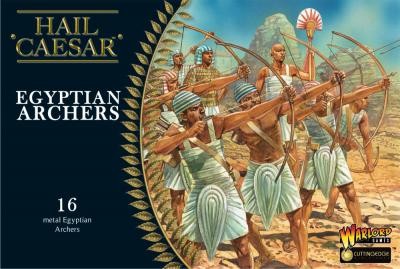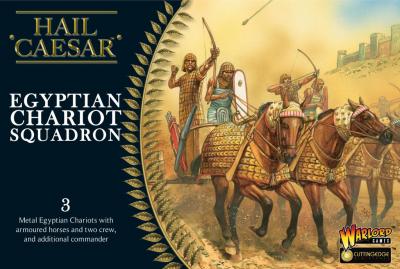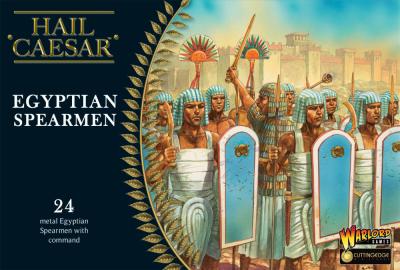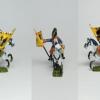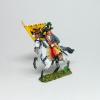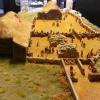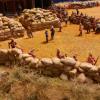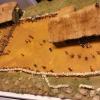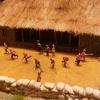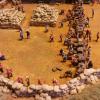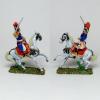Warlord Games
-
Egyptian Chariot Squadron
WGH-CEM-04-Egyptian-Chariot-SquadronWGH-CEM-04-Egyptian-Chariot-Squadron A l’avant des armées du Pharaon se trouvaient les plus puissantes armes d’un âge nouveau : les chars de guerre ! Les chars égyptiens étaient de fabrication légère, avec un équipage composé d’un conducteur et d’un guerrier armé d’un arc et de plusieurs javelots courts, qui pouvaient être lancés ou utilisés pour poignarder l’adversaire. Construire des chars était coûteux, et ils étaient fréquemment décorés de façon élaborée ou dorés à l’or fin. Après une bataille, les chars étaient listés parmi les butins de guerre. Durant le Nouvel Empire, la Syrie devint le champ de bataille des empires de cette époque. Thoutmosis III (1479-1425 av. J.-C.) fit campagne contre les cités de Canaan et de Syrie, et ces nombreuses conquêtes lui ont valu le titre de « Napoléon de l’Ancienne Égypte ». Lors de la bataille de Megiddo il affronta une coalition de Cananéens conduits par le Roi de Kadesh, remportant ainsi la plus grande victoire de son règne. The Eighteenth, Nineteenth and Twentieth dynasties comprise the age of the Egyptian New Kingdom (1550-1077BC). During these years a succession of warrior pharaohs led Egyptian forces in wars of conquest, southwards to Nubia and northwards to Canaan, Amurru and Syria. At the forefront of the pharaohs’ armies were the most powerful weapons of the new age – chariots! Egyptian chariots were lightly built, and were crewed by a driver and a fighter armed with a bow and a number of short spears, which could be thrown or used to stab at the enemy. Chariots were expensive to make, and were often elaborately decorated or gilded. After a battle, captured chariots were listed amongst the spoils of war. During the New Kingdom Syria became a battleground for the empires of the age. Thuthmosis III (ruled 1479-1425 BC) campaigned against the cities of Canaan and Syria, and his many conquests have earned him the title of ‘Napoleon of Ancient Egypt’. At the Battle of Megiddo he fought against a coalition of Canaanites led by the King of Kadesh, winning the greatest victory of his reign. Afterwards the Hittites, Babylonians and Assyrians all acknowledged the pharaoh’s might with tributary gifts – only the Mitanni failed to do so – and Thuthmosis took his revenge by leading a campaign across the Euphrates and wreaking devastation upon the Mitannian King’s cities! Boxed set containing three metal Chariots
41.6€ TTC
-
Egyptian Spearmen
Egyptian Spearmen Les Pharaons d’Égypte conduisirent leurs armées à travers Canaan et en Syrie au cours d’une succession de guerres tout au long du Nouvel Empire. L’infanterie formait l’ossature de ces forces, comprenant des archers et des combattants de corps-à-corps armées d’épieux, d’épées et parfois de lourdes armes contondantes. La lance égyptienne n’était pas particulièrement longue, et était principalement conçue comme une arme de jet dont l’utilisateur brandirait dans la foulée son épée khopesh à lame de faucille. 24 Crew Metal The Egyptian pharaohs led their armies through Canaan and into Syria in a succession of wars throughout the age of the New Kingdom. Infantry formed the backbone of these forces, comprising archers and close fighters armed with spears, swords, and sometimes with heavy mace-like weapons. The Egyptian spear was not especially long, and was primarily a throwing weapon whose user would follow up with the deadly khopesh sickle-sword. From the reign of Akhenaten (1379-1362BC) if not earlier, the Egyptian infantryman benefited from the addition of distinctive banded armour made from stiffened or reinforced fabric, images of warriors so equipped were discovered in the tomb of Tutankhamun. The banded headcloth, so commonly associated with Egyptian infantry, is a typical feature of troops from the later Nineteenth dynasty, reflecting the appearance of the armies of such mighty warriors as Ramesses II and later pharaohs. It may conceal a helmet or could be a padded or plaited headdress – we don’t know for sure. These troops carry a larger shield than that of earlier close-fighting infantry, more suitable for fighting in dense formations. Shields are shown painted in a solid colour such as red or blue, with a white border decorated with black, blue and red lines. Shields were often slung on the back, even in combat, and were used to form a palisade around the army’s encampment.
36.4€ TTC








